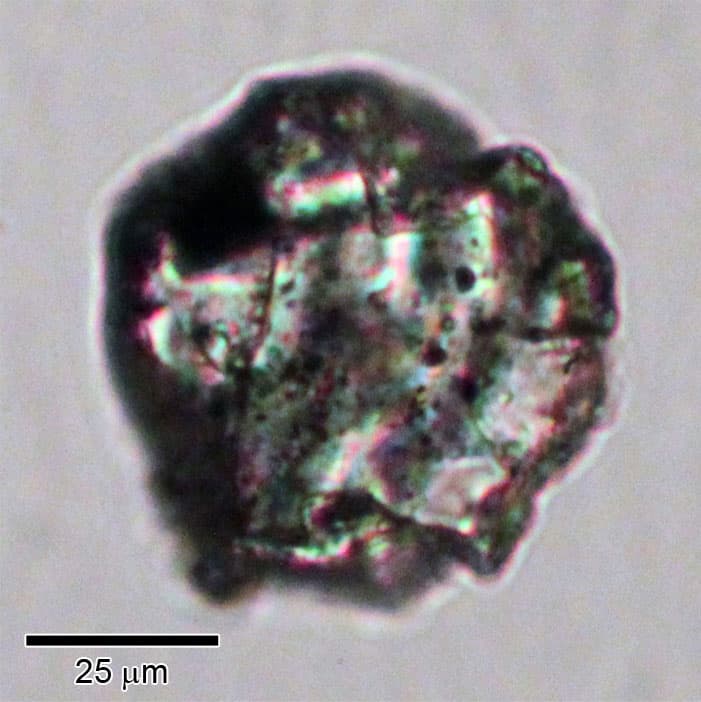
Eight years after the Hayabusa mission was launched to retrieve material from a near-Earth asteroid, the first scientific analyses of these rocks have been released. Among the findings published by an international team of scientists is the discovery that common chondrites found on Earth derive from the same origins as this stony “S type” asteroid. The implication is that meteorites scattered across the globe may contain preserved information about the early solar system.
The Hayabusa mission, launched by the Japanese space agency JAXA in 2003, was designed to land on the Itokawa asteroid – a 500 m-long body that lies around 300 million kilometres away from Earth – and return a sample to Earth by 2007. But having landed on the surface of Itokawa to collect samples in November 2005, technical glitches including being hit by a solar flare caused the return of the mission to be delayed for an additional three years. It eventually landed in the Woomera Prohibited Area in Southern Australia in June 2010, and the largely intact probe containing 1500 extraterrestrial grains was sent back to Japan for examination.
Parent rock
The essential result of the analysis of the 40 particles the researchers have looked at has confirmed the belief that the most common meteorites found here on Earth, known as ordinary chondrites, are born from S-type asteroids like Itokawa. The main goal of the Hayabusa mission was to demonstrate that S-type asteroids are primitive solar system bodies that “record” the long history of early solar system events.
Tomoki Nakamura from Tohoku University, Japan, and colleagues are the first to analyse the loose surface material, or regolith, that was brought back, using electron microscopes and X-ray diffraction techniques. “In our experiments, we analysed single particles by applying different techniques in order to know different aspects of the [same] particle. We needed to show asteroidal material is identical to chondrite meteorites, because we already knew that the chondrites are most primitive materials in the solar system,” explains Nakamura, who is one of the lead authors of a series of six papers published in the journal Science this week. All six papers are by the same team, with different lead authors looking at various aspects of the research that were conducted with different techniques.
The lead paper states that the regolith samples show signs of impact shocks and a large amount of heating. This suggests that the asteroid underwent a thermal evolution as the interior slowly heated up and reached a peak temperature of 800 °C, before it cooled down again very slowly. Because many of the particles studied had experienced this high temperature, this suggests that the particles on the surface of the asteroid were once at considerable depths within its body. This led the team to conclude that the asteroid was initially a much bigger body that suffered a large impact. “The size reduction occurred during a heavy impact that broke the parent body of 20 km into small pieces; some of which gathered again to form the [current] 0.5 km asteroid Itokawa,” says Nakamura. The researchers now believe that the formation time of Itokawa goes back to the early solar system 4.5 billion years ago.
Spectrum of results
The other papers published by the group cover a host of topics – one looks at the oxygen isotope ratios and minor element abundances in Itokawa particles, while another ties S-type asteroids with chondrite meteorites. Another paper investigates evolution processes of the asteroid’s surface. This led to the finding that the particles on the surface were first formed by fragmentation of larger rocks. In addition, exposure to solar winds has changed the colour of the particles and seismic activity in smooth terrain has reduced their size gradually.
Through this analysis we now have a detailed understanding of the history of asteroid formation. So tiny particles gave us a big result.Tomoki Nakamura, Tohoku University, Japan
Another study compared the dust with regolith sampled from the Moon, showing that there are chemical differences between lunar dust and the Itokawa samples. The researchers attribute these differences to chemical alteration by space-weathering and meteoroid impacts on the asteroid surface. A final paper looks at the noble gas isotopes helium, neon and argon to map a history of irradiation from solar wind and cosmic rays on the asteroid’s surface. The team found that Itokawa is continuously losing its surface materials at the rate of tens of centimetres per billion years.
Nakamura says that he was rather surprised to see just how similar the asteroid particles were to chondrites. “When I analyse the particles I always feel I am analysing meteorites,” he said. He also said that the results have helped with better understanding of asteroid formation. “The particles recovered from the asteroid Itokawa are very small, mostly less than 0.1 mm. But through this analysis we now have a detailed understanding of the history of asteroid formation. So tiny particles gave us a big result.”




